Counselling Theories: Understanding Depression and Psychoanalytic and CBT Strategies
VerifiedAdded on 2023/06/05
|13
|3688
|299
AI Summary
This report delves into the intricacies of counselling theories and their practical applications. It explores depression, its challenges, and psychoanalytic and CBT strategies for treatment. The report discusses the principles, strategies, and practical applications of psychoanalytic and CBT therapies.
Contribute Materials
Your contribution can guide someone’s learning journey. Share your
documents today.
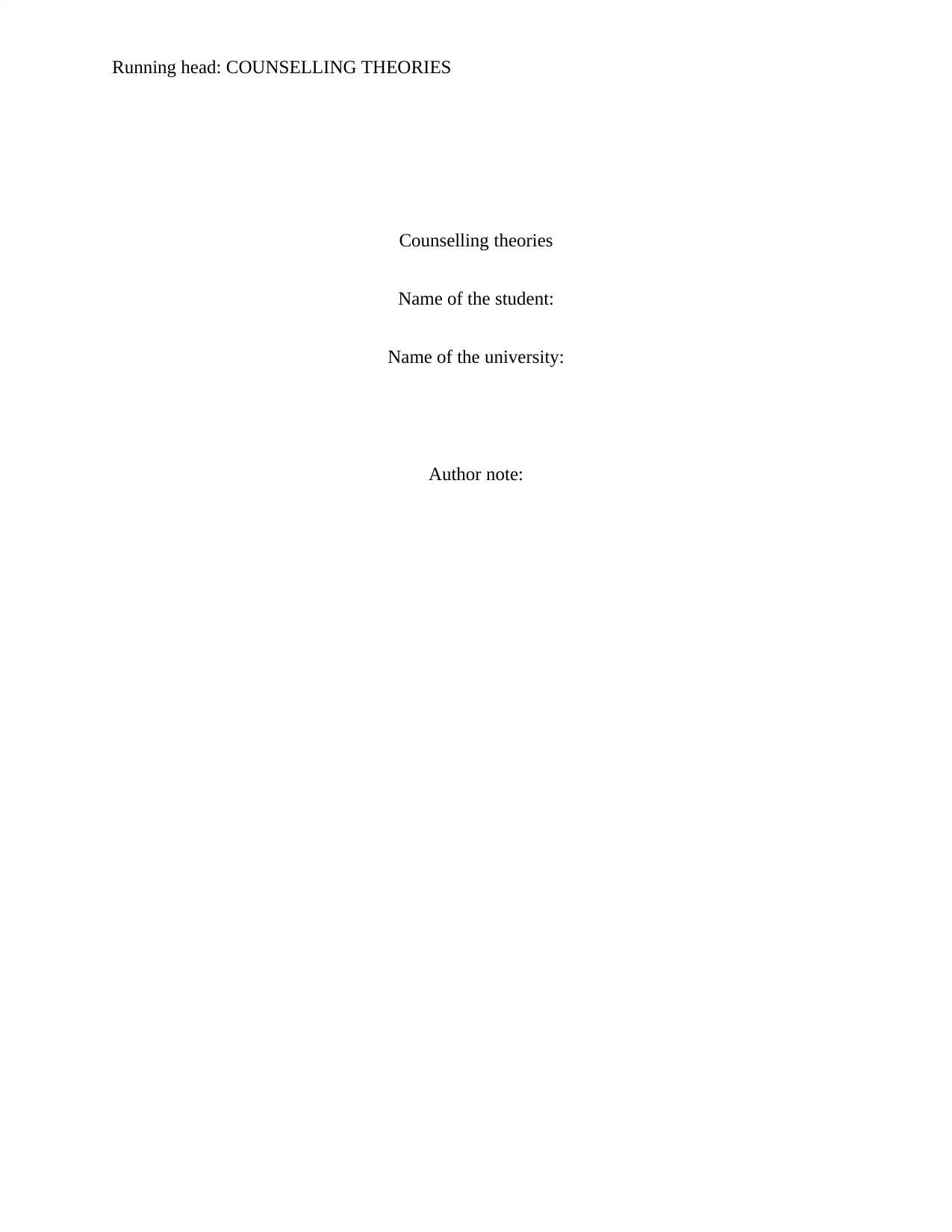
Running head: COUNSELLING THEORIES
Counselling theories
Name of the student:
Name of the university:
Author note:
Counselling theories
Name of the student:
Name of the university:
Author note:
Secure Best Marks with AI Grader
Need help grading? Try our AI Grader for instant feedback on your assignments.
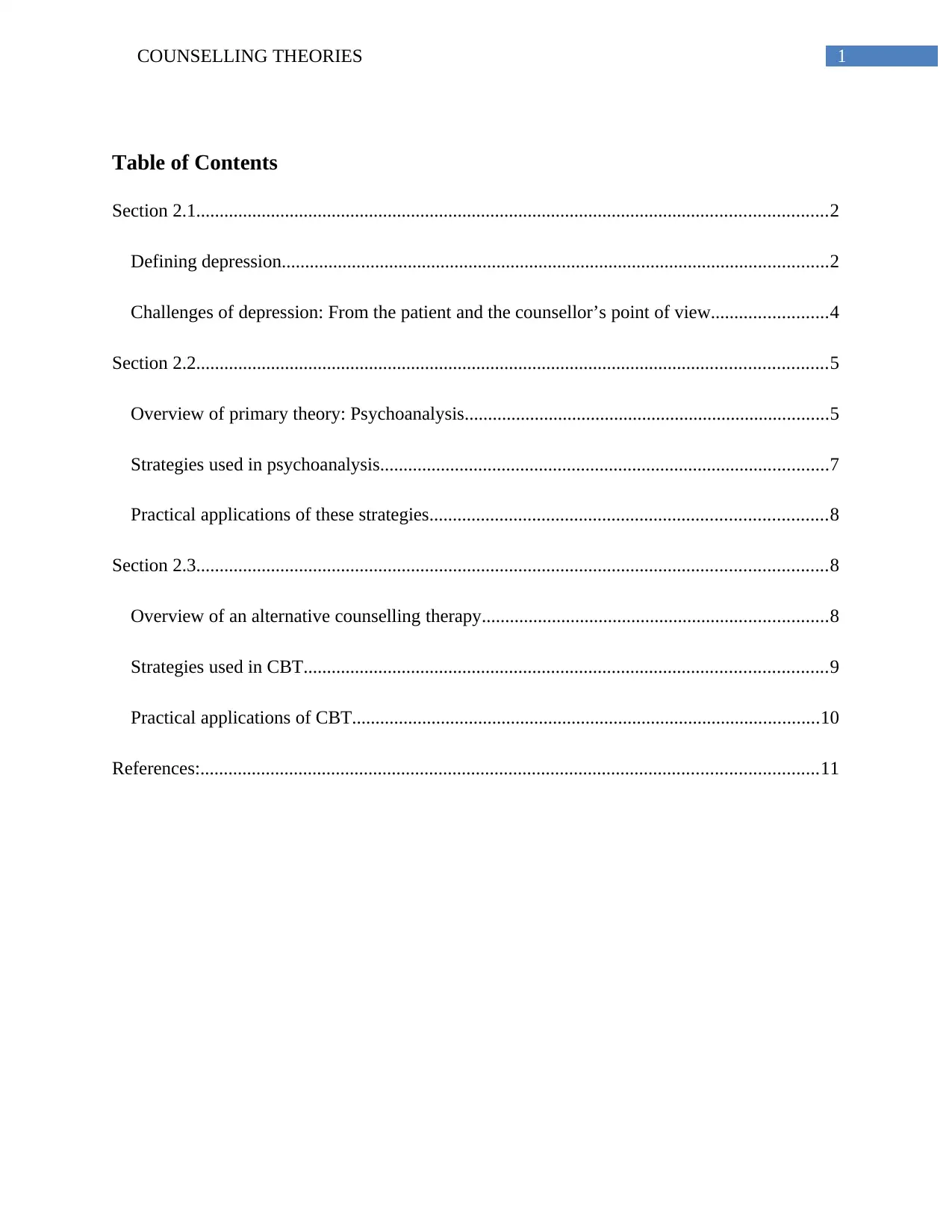
1COUNSELLING THEORIES
Table of Contents
Section 2.1.......................................................................................................................................2
Defining depression.....................................................................................................................2
Challenges of depression: From the patient and the counsellor’s point of view.........................4
Section 2.2.......................................................................................................................................5
Overview of primary theory: Psychoanalysis..............................................................................5
Strategies used in psychoanalysis................................................................................................7
Practical applications of these strategies.....................................................................................8
Section 2.3.......................................................................................................................................8
Overview of an alternative counselling therapy..........................................................................8
Strategies used in CBT................................................................................................................9
Practical applications of CBT....................................................................................................10
References:....................................................................................................................................11
Table of Contents
Section 2.1.......................................................................................................................................2
Defining depression.....................................................................................................................2
Challenges of depression: From the patient and the counsellor’s point of view.........................4
Section 2.2.......................................................................................................................................5
Overview of primary theory: Psychoanalysis..............................................................................5
Strategies used in psychoanalysis................................................................................................7
Practical applications of these strategies.....................................................................................8
Section 2.3.......................................................................................................................................8
Overview of an alternative counselling therapy..........................................................................8
Strategies used in CBT................................................................................................................9
Practical applications of CBT....................................................................................................10
References:....................................................................................................................................11
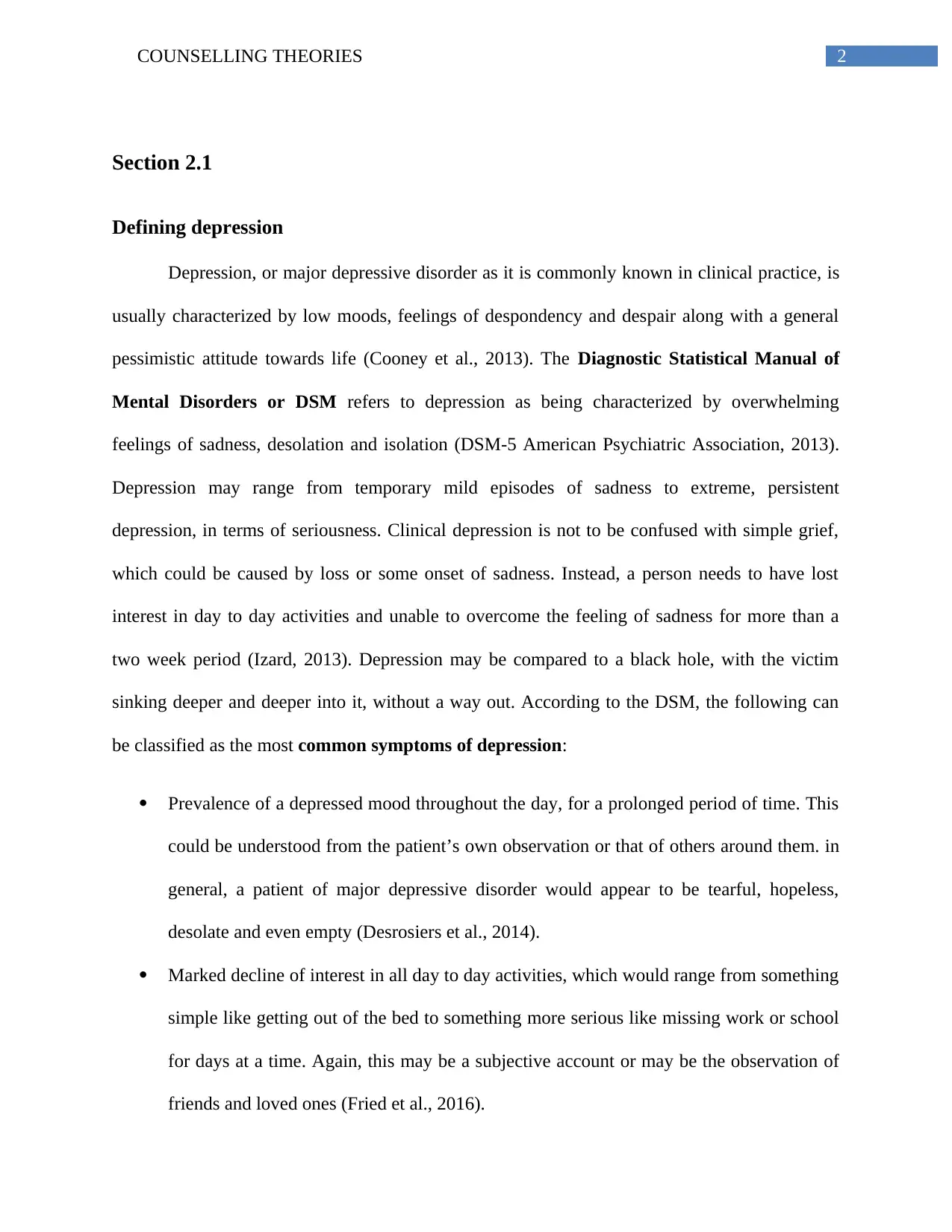
2COUNSELLING THEORIES
Section 2.1
Defining depression
Depression, or major depressive disorder as it is commonly known in clinical practice, is
usually characterized by low moods, feelings of despondency and despair along with a general
pessimistic attitude towards life (Cooney et al., 2013). The Diagnostic Statistical Manual of
Mental Disorders or DSM refers to depression as being characterized by overwhelming
feelings of sadness, desolation and isolation (DSM-5 American Psychiatric Association, 2013).
Depression may range from temporary mild episodes of sadness to extreme, persistent
depression, in terms of seriousness. Clinical depression is not to be confused with simple grief,
which could be caused by loss or some onset of sadness. Instead, a person needs to have lost
interest in day to day activities and unable to overcome the feeling of sadness for more than a
two week period (Izard, 2013). Depression may be compared to a black hole, with the victim
sinking deeper and deeper into it, without a way out. According to the DSM, the following can
be classified as the most common symptoms of depression:
Prevalence of a depressed mood throughout the day, for a prolonged period of time. This
could be understood from the patient’s own observation or that of others around them. in
general, a patient of major depressive disorder would appear to be tearful, hopeless,
desolate and even empty (Desrosiers et al., 2014).
Marked decline of interest in all day to day activities, which would range from something
simple like getting out of the bed to something more serious like missing work or school
for days at a time. Again, this may be a subjective account or may be the observation of
friends and loved ones (Fried et al., 2016).
Section 2.1
Defining depression
Depression, or major depressive disorder as it is commonly known in clinical practice, is
usually characterized by low moods, feelings of despondency and despair along with a general
pessimistic attitude towards life (Cooney et al., 2013). The Diagnostic Statistical Manual of
Mental Disorders or DSM refers to depression as being characterized by overwhelming
feelings of sadness, desolation and isolation (DSM-5 American Psychiatric Association, 2013).
Depression may range from temporary mild episodes of sadness to extreme, persistent
depression, in terms of seriousness. Clinical depression is not to be confused with simple grief,
which could be caused by loss or some onset of sadness. Instead, a person needs to have lost
interest in day to day activities and unable to overcome the feeling of sadness for more than a
two week period (Izard, 2013). Depression may be compared to a black hole, with the victim
sinking deeper and deeper into it, without a way out. According to the DSM, the following can
be classified as the most common symptoms of depression:
Prevalence of a depressed mood throughout the day, for a prolonged period of time. This
could be understood from the patient’s own observation or that of others around them. in
general, a patient of major depressive disorder would appear to be tearful, hopeless,
desolate and even empty (Desrosiers et al., 2014).
Marked decline of interest in all day to day activities, which would range from something
simple like getting out of the bed to something more serious like missing work or school
for days at a time. Again, this may be a subjective account or may be the observation of
friends and loved ones (Fried et al., 2016).
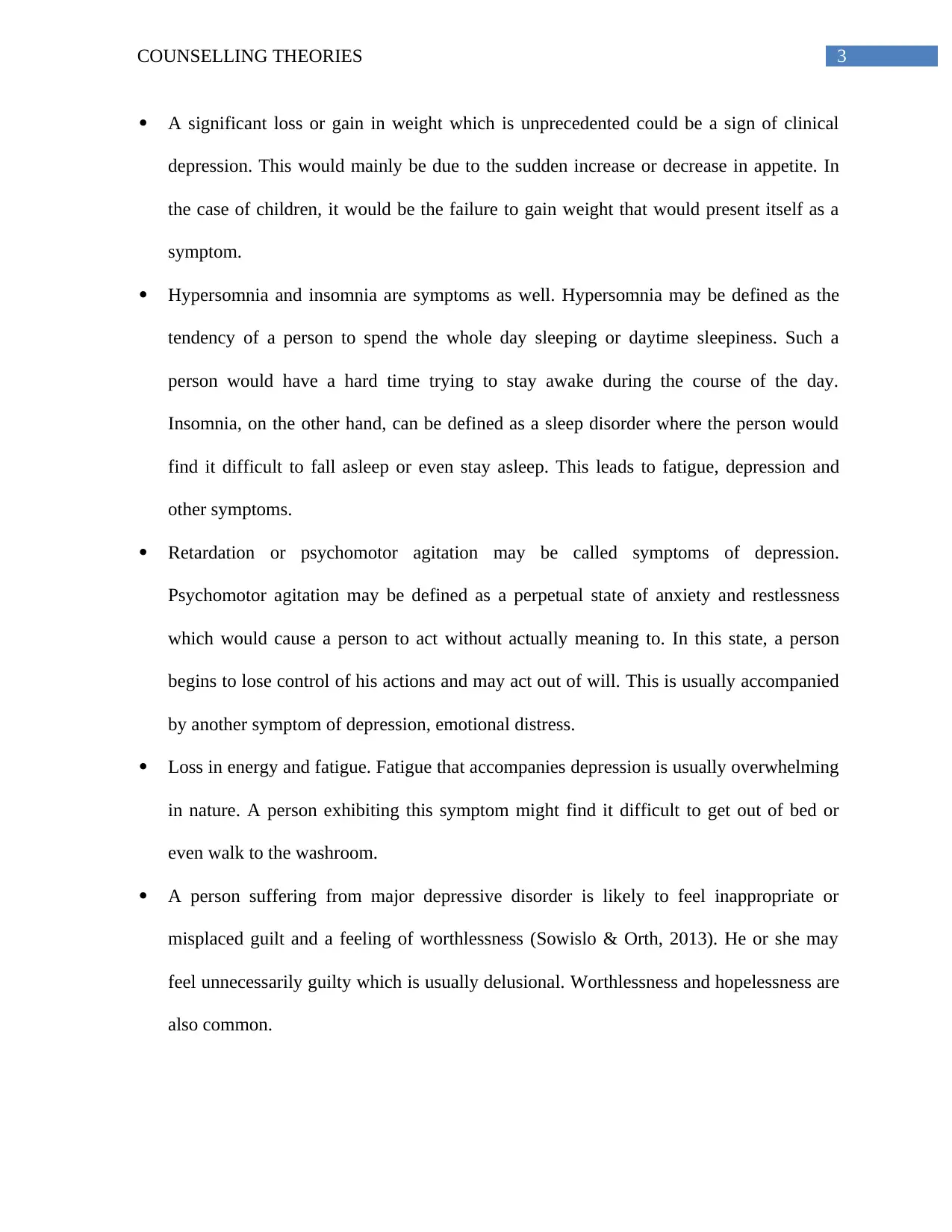
3COUNSELLING THEORIES
A significant loss or gain in weight which is unprecedented could be a sign of clinical
depression. This would mainly be due to the sudden increase or decrease in appetite. In
the case of children, it would be the failure to gain weight that would present itself as a
symptom.
Hypersomnia and insomnia are symptoms as well. Hypersomnia may be defined as the
tendency of a person to spend the whole day sleeping or daytime sleepiness. Such a
person would have a hard time trying to stay awake during the course of the day.
Insomnia, on the other hand, can be defined as a sleep disorder where the person would
find it difficult to fall asleep or even stay asleep. This leads to fatigue, depression and
other symptoms.
Retardation or psychomotor agitation may be called symptoms of depression.
Psychomotor agitation may be defined as a perpetual state of anxiety and restlessness
which would cause a person to act without actually meaning to. In this state, a person
begins to lose control of his actions and may act out of will. This is usually accompanied
by another symptom of depression, emotional distress.
Loss in energy and fatigue. Fatigue that accompanies depression is usually overwhelming
in nature. A person exhibiting this symptom might find it difficult to get out of bed or
even walk to the washroom.
A person suffering from major depressive disorder is likely to feel inappropriate or
misplaced guilt and a feeling of worthlessness (Sowislo & Orth, 2013). He or she may
feel unnecessarily guilty which is usually delusional. Worthlessness and hopelessness are
also common.
A significant loss or gain in weight which is unprecedented could be a sign of clinical
depression. This would mainly be due to the sudden increase or decrease in appetite. In
the case of children, it would be the failure to gain weight that would present itself as a
symptom.
Hypersomnia and insomnia are symptoms as well. Hypersomnia may be defined as the
tendency of a person to spend the whole day sleeping or daytime sleepiness. Such a
person would have a hard time trying to stay awake during the course of the day.
Insomnia, on the other hand, can be defined as a sleep disorder where the person would
find it difficult to fall asleep or even stay asleep. This leads to fatigue, depression and
other symptoms.
Retardation or psychomotor agitation may be called symptoms of depression.
Psychomotor agitation may be defined as a perpetual state of anxiety and restlessness
which would cause a person to act without actually meaning to. In this state, a person
begins to lose control of his actions and may act out of will. This is usually accompanied
by another symptom of depression, emotional distress.
Loss in energy and fatigue. Fatigue that accompanies depression is usually overwhelming
in nature. A person exhibiting this symptom might find it difficult to get out of bed or
even walk to the washroom.
A person suffering from major depressive disorder is likely to feel inappropriate or
misplaced guilt and a feeling of worthlessness (Sowislo & Orth, 2013). He or she may
feel unnecessarily guilty which is usually delusional. Worthlessness and hopelessness are
also common.
Secure Best Marks with AI Grader
Need help grading? Try our AI Grader for instant feedback on your assignments.
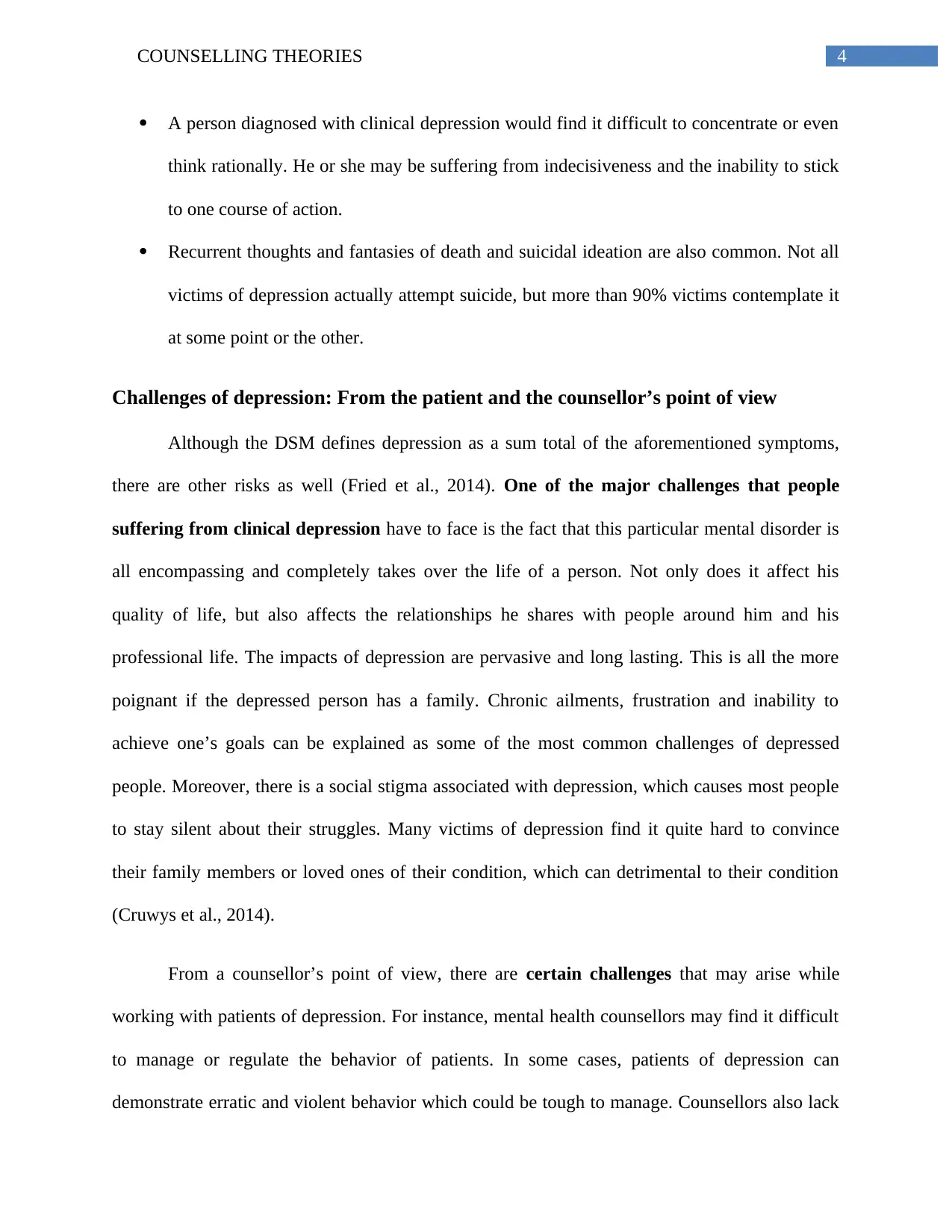
4COUNSELLING THEORIES
A person diagnosed with clinical depression would find it difficult to concentrate or even
think rationally. He or she may be suffering from indecisiveness and the inability to stick
to one course of action.
Recurrent thoughts and fantasies of death and suicidal ideation are also common. Not all
victims of depression actually attempt suicide, but more than 90% victims contemplate it
at some point or the other.
Challenges of depression: From the patient and the counsellor’s point of view
Although the DSM defines depression as a sum total of the aforementioned symptoms,
there are other risks as well (Fried et al., 2014). One of the major challenges that people
suffering from clinical depression have to face is the fact that this particular mental disorder is
all encompassing and completely takes over the life of a person. Not only does it affect his
quality of life, but also affects the relationships he shares with people around him and his
professional life. The impacts of depression are pervasive and long lasting. This is all the more
poignant if the depressed person has a family. Chronic ailments, frustration and inability to
achieve one’s goals can be explained as some of the most common challenges of depressed
people. Moreover, there is a social stigma associated with depression, which causes most people
to stay silent about their struggles. Many victims of depression find it quite hard to convince
their family members or loved ones of their condition, which can detrimental to their condition
(Cruwys et al., 2014).
From a counsellor’s point of view, there are certain challenges that may arise while
working with patients of depression. For instance, mental health counsellors may find it difficult
to manage or regulate the behavior of patients. In some cases, patients of depression can
demonstrate erratic and violent behavior which could be tough to manage. Counsellors also lack
A person diagnosed with clinical depression would find it difficult to concentrate or even
think rationally. He or she may be suffering from indecisiveness and the inability to stick
to one course of action.
Recurrent thoughts and fantasies of death and suicidal ideation are also common. Not all
victims of depression actually attempt suicide, but more than 90% victims contemplate it
at some point or the other.
Challenges of depression: From the patient and the counsellor’s point of view
Although the DSM defines depression as a sum total of the aforementioned symptoms,
there are other risks as well (Fried et al., 2014). One of the major challenges that people
suffering from clinical depression have to face is the fact that this particular mental disorder is
all encompassing and completely takes over the life of a person. Not only does it affect his
quality of life, but also affects the relationships he shares with people around him and his
professional life. The impacts of depression are pervasive and long lasting. This is all the more
poignant if the depressed person has a family. Chronic ailments, frustration and inability to
achieve one’s goals can be explained as some of the most common challenges of depressed
people. Moreover, there is a social stigma associated with depression, which causes most people
to stay silent about their struggles. Many victims of depression find it quite hard to convince
their family members or loved ones of their condition, which can detrimental to their condition
(Cruwys et al., 2014).
From a counsellor’s point of view, there are certain challenges that may arise while
working with patients of depression. For instance, mental health counsellors may find it difficult
to manage or regulate the behavior of patients. In some cases, patients of depression can
demonstrate erratic and violent behavior which could be tough to manage. Counsellors also lack
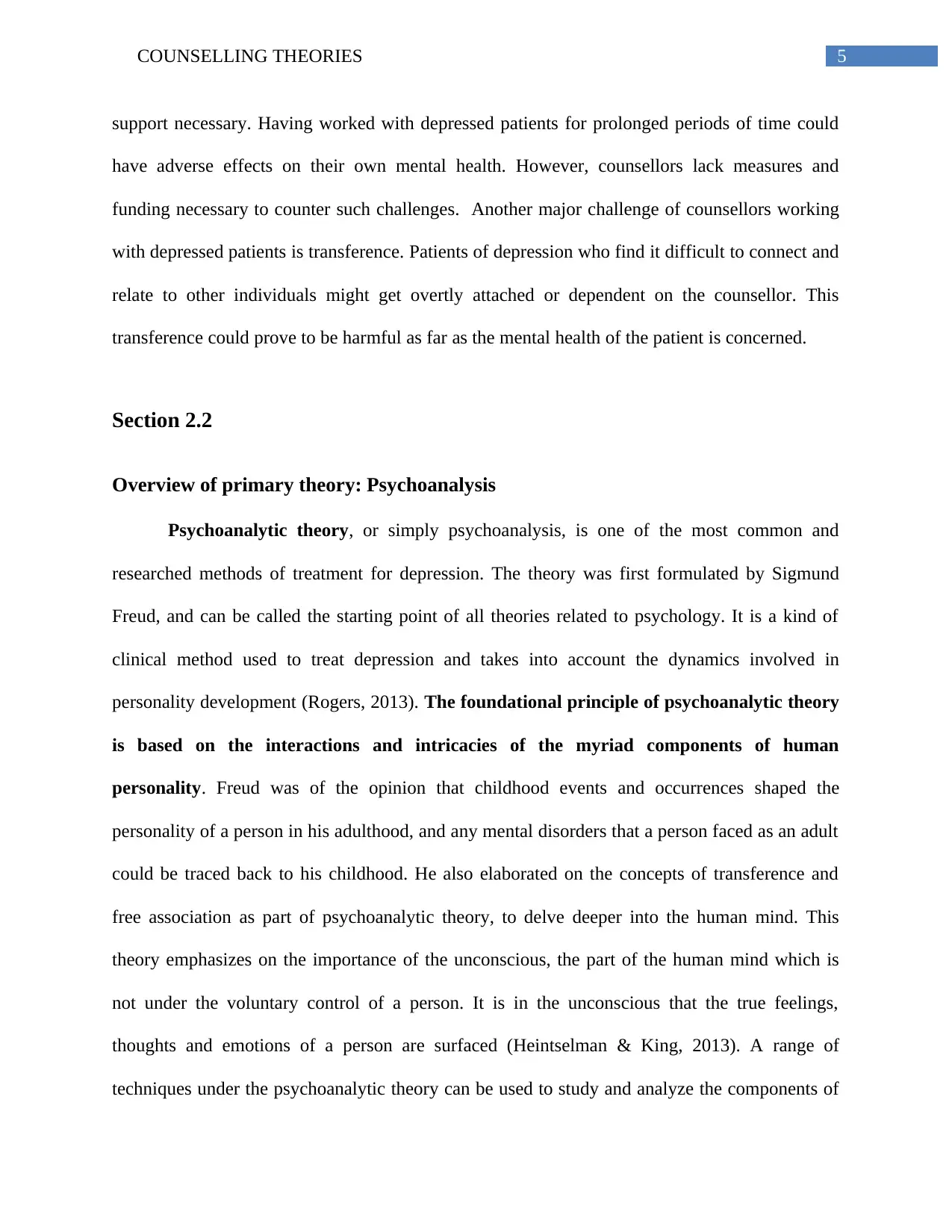
5COUNSELLING THEORIES
support necessary. Having worked with depressed patients for prolonged periods of time could
have adverse effects on their own mental health. However, counsellors lack measures and
funding necessary to counter such challenges. Another major challenge of counsellors working
with depressed patients is transference. Patients of depression who find it difficult to connect and
relate to other individuals might get overtly attached or dependent on the counsellor. This
transference could prove to be harmful as far as the mental health of the patient is concerned.
Section 2.2
Overview of primary theory: Psychoanalysis
Psychoanalytic theory, or simply psychoanalysis, is one of the most common and
researched methods of treatment for depression. The theory was first formulated by Sigmund
Freud, and can be called the starting point of all theories related to psychology. It is a kind of
clinical method used to treat depression and takes into account the dynamics involved in
personality development (Rogers, 2013). The foundational principle of psychoanalytic theory
is based on the interactions and intricacies of the myriad components of human
personality. Freud was of the opinion that childhood events and occurrences shaped the
personality of a person in his adulthood, and any mental disorders that a person faced as an adult
could be traced back to his childhood. He also elaborated on the concepts of transference and
free association as part of psychoanalytic theory, to delve deeper into the human mind. This
theory emphasizes on the importance of the unconscious, the part of the human mind which is
not under the voluntary control of a person. It is in the unconscious that the true feelings,
thoughts and emotions of a person are surfaced (Heintselman & King, 2013). A range of
techniques under the psychoanalytic theory can be used to study and analyze the components of
support necessary. Having worked with depressed patients for prolonged periods of time could
have adverse effects on their own mental health. However, counsellors lack measures and
funding necessary to counter such challenges. Another major challenge of counsellors working
with depressed patients is transference. Patients of depression who find it difficult to connect and
relate to other individuals might get overtly attached or dependent on the counsellor. This
transference could prove to be harmful as far as the mental health of the patient is concerned.
Section 2.2
Overview of primary theory: Psychoanalysis
Psychoanalytic theory, or simply psychoanalysis, is one of the most common and
researched methods of treatment for depression. The theory was first formulated by Sigmund
Freud, and can be called the starting point of all theories related to psychology. It is a kind of
clinical method used to treat depression and takes into account the dynamics involved in
personality development (Rogers, 2013). The foundational principle of psychoanalytic theory
is based on the interactions and intricacies of the myriad components of human
personality. Freud was of the opinion that childhood events and occurrences shaped the
personality of a person in his adulthood, and any mental disorders that a person faced as an adult
could be traced back to his childhood. He also elaborated on the concepts of transference and
free association as part of psychoanalytic theory, to delve deeper into the human mind. This
theory emphasizes on the importance of the unconscious, the part of the human mind which is
not under the voluntary control of a person. It is in the unconscious that the true feelings,
thoughts and emotions of a person are surfaced (Heintselman & King, 2013). A range of
techniques under the psychoanalytic theory can be used to study and analyze the components of
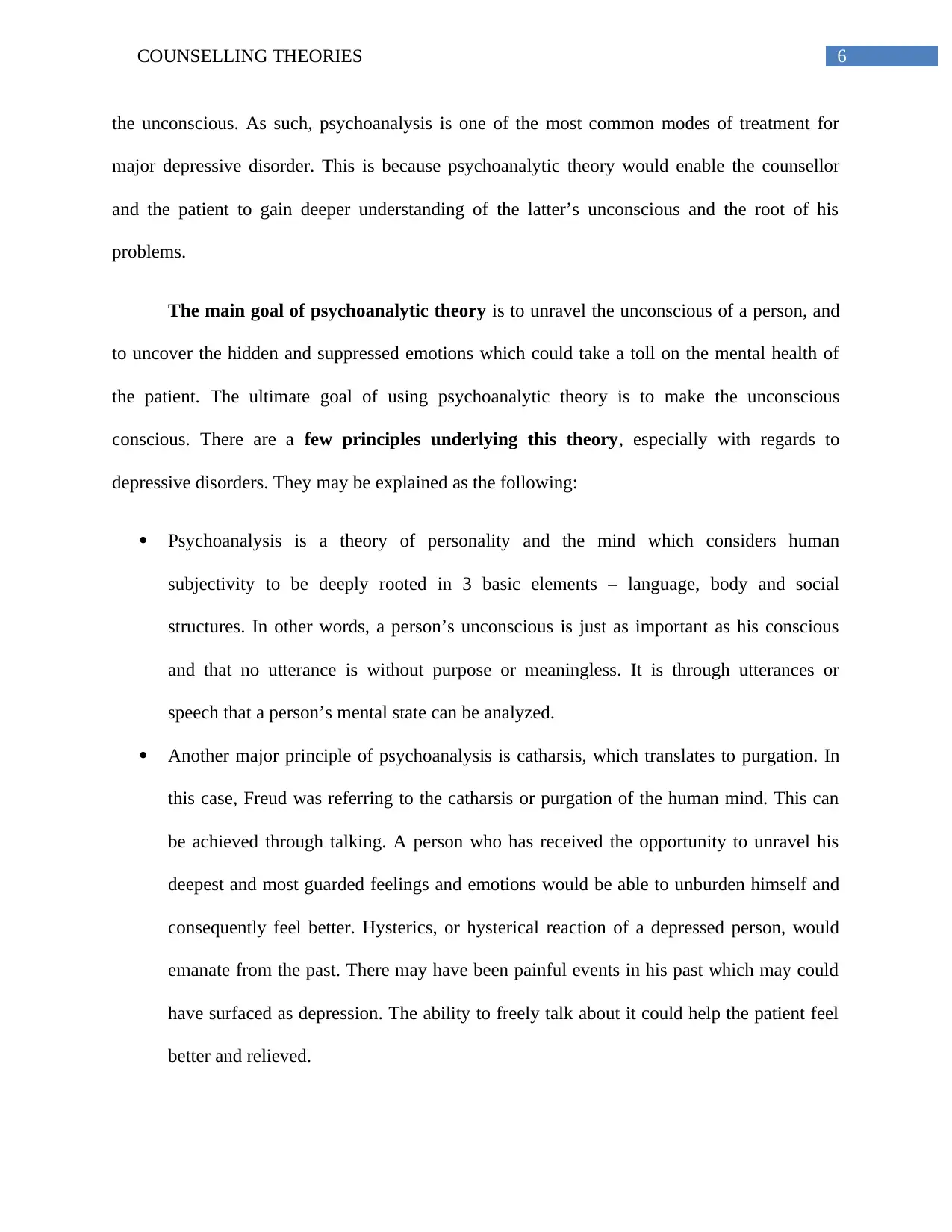
6COUNSELLING THEORIES
the unconscious. As such, psychoanalysis is one of the most common modes of treatment for
major depressive disorder. This is because psychoanalytic theory would enable the counsellor
and the patient to gain deeper understanding of the latter’s unconscious and the root of his
problems.
The main goal of psychoanalytic theory is to unravel the unconscious of a person, and
to uncover the hidden and suppressed emotions which could take a toll on the mental health of
the patient. The ultimate goal of using psychoanalytic theory is to make the unconscious
conscious. There are a few principles underlying this theory, especially with regards to
depressive disorders. They may be explained as the following:
Psychoanalysis is a theory of personality and the mind which considers human
subjectivity to be deeply rooted in 3 basic elements – language, body and social
structures. In other words, a person’s unconscious is just as important as his conscious
and that no utterance is without purpose or meaningless. It is through utterances or
speech that a person’s mental state can be analyzed.
Another major principle of psychoanalysis is catharsis, which translates to purgation. In
this case, Freud was referring to the catharsis or purgation of the human mind. This can
be achieved through talking. A person who has received the opportunity to unravel his
deepest and most guarded feelings and emotions would be able to unburden himself and
consequently feel better. Hysterics, or hysterical reaction of a depressed person, would
emanate from the past. There may have been painful events in his past which may could
have surfaced as depression. The ability to freely talk about it could help the patient feel
better and relieved.
the unconscious. As such, psychoanalysis is one of the most common modes of treatment for
major depressive disorder. This is because psychoanalytic theory would enable the counsellor
and the patient to gain deeper understanding of the latter’s unconscious and the root of his
problems.
The main goal of psychoanalytic theory is to unravel the unconscious of a person, and
to uncover the hidden and suppressed emotions which could take a toll on the mental health of
the patient. The ultimate goal of using psychoanalytic theory is to make the unconscious
conscious. There are a few principles underlying this theory, especially with regards to
depressive disorders. They may be explained as the following:
Psychoanalysis is a theory of personality and the mind which considers human
subjectivity to be deeply rooted in 3 basic elements – language, body and social
structures. In other words, a person’s unconscious is just as important as his conscious
and that no utterance is without purpose or meaningless. It is through utterances or
speech that a person’s mental state can be analyzed.
Another major principle of psychoanalysis is catharsis, which translates to purgation. In
this case, Freud was referring to the catharsis or purgation of the human mind. This can
be achieved through talking. A person who has received the opportunity to unravel his
deepest and most guarded feelings and emotions would be able to unburden himself and
consequently feel better. Hysterics, or hysterical reaction of a depressed person, would
emanate from the past. There may have been painful events in his past which may could
have surfaced as depression. The ability to freely talk about it could help the patient feel
better and relieved.
Paraphrase This Document
Need a fresh take? Get an instant paraphrase of this document with our AI Paraphraser

7COUNSELLING THEORIES
The unconscious of the human mind is the fundamental principle underlying
psychoanalytic theory. According to Freud, it is the human unconscious which harbors
the latent feelings, emotions and thoughts. Various techniques or methods in
psychoanalysis like dream analysis, free association, hypnosis and others can be used to
unravel a person’s unconscious (Bargh, 2014).
Strategies used in psychoanalysis
Free association – This is one of the most common strategies used by counsellors to
assess the mental state of patients suffering from depression. In this strategy, the
counsellor is expected to read out a list of words, and the client would be expected to
utter the first word that comes to their mind (Joffe & Elsey, 2014). It is expected that
through free association, the counsellor would be able to surface certain repressed
memories.
Dream analysis – Freud believed that dreams are the ultimate road to unconscious.
Through analysis of one’s dreams, it is possible to understand the repressed emotions and
feelings of a person. This is mainly because a person is less likely to have his guards up
while asleep.
Transference – Patients of depression find it difficult to develop healthy social
relationships. Hence, transference is a challenge when it comes to psychoanalysis as
patients may become increasingly dependent on the counsellor. Thus, timelines must be
set by the counsellor to avoid transference which could prove to be more damaging.
Empowerment – One of the major aspects of psychoanalytic therapy is helping the
individual feel better and more confident about himself. The role of the counsellor is to
empower the client and reduce feelings of worthlessness or helplessness.
The unconscious of the human mind is the fundamental principle underlying
psychoanalytic theory. According to Freud, it is the human unconscious which harbors
the latent feelings, emotions and thoughts. Various techniques or methods in
psychoanalysis like dream analysis, free association, hypnosis and others can be used to
unravel a person’s unconscious (Bargh, 2014).
Strategies used in psychoanalysis
Free association – This is one of the most common strategies used by counsellors to
assess the mental state of patients suffering from depression. In this strategy, the
counsellor is expected to read out a list of words, and the client would be expected to
utter the first word that comes to their mind (Joffe & Elsey, 2014). It is expected that
through free association, the counsellor would be able to surface certain repressed
memories.
Dream analysis – Freud believed that dreams are the ultimate road to unconscious.
Through analysis of one’s dreams, it is possible to understand the repressed emotions and
feelings of a person. This is mainly because a person is less likely to have his guards up
while asleep.
Transference – Patients of depression find it difficult to develop healthy social
relationships. Hence, transference is a challenge when it comes to psychoanalysis as
patients may become increasingly dependent on the counsellor. Thus, timelines must be
set by the counsellor to avoid transference which could prove to be more damaging.
Empowerment – One of the major aspects of psychoanalytic therapy is helping the
individual feel better and more confident about himself. The role of the counsellor is to
empower the client and reduce feelings of worthlessness or helplessness.
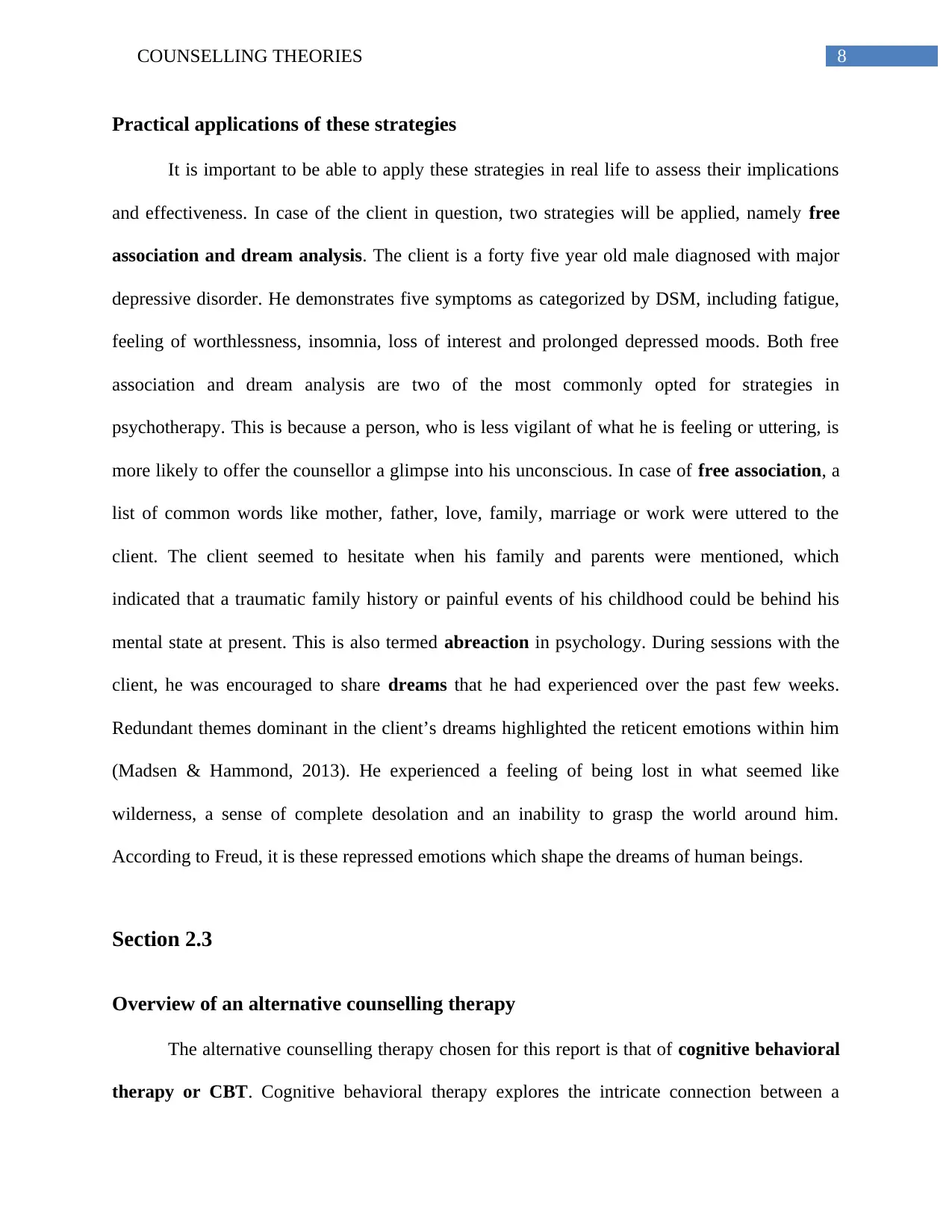
8COUNSELLING THEORIES
Practical applications of these strategies
It is important to be able to apply these strategies in real life to assess their implications
and effectiveness. In case of the client in question, two strategies will be applied, namely free
association and dream analysis. The client is a forty five year old male diagnosed with major
depressive disorder. He demonstrates five symptoms as categorized by DSM, including fatigue,
feeling of worthlessness, insomnia, loss of interest and prolonged depressed moods. Both free
association and dream analysis are two of the most commonly opted for strategies in
psychotherapy. This is because a person, who is less vigilant of what he is feeling or uttering, is
more likely to offer the counsellor a glimpse into his unconscious. In case of free association, a
list of common words like mother, father, love, family, marriage or work were uttered to the
client. The client seemed to hesitate when his family and parents were mentioned, which
indicated that a traumatic family history or painful events of his childhood could be behind his
mental state at present. This is also termed abreaction in psychology. During sessions with the
client, he was encouraged to share dreams that he had experienced over the past few weeks.
Redundant themes dominant in the client’s dreams highlighted the reticent emotions within him
(Madsen & Hammond, 2013). He experienced a feeling of being lost in what seemed like
wilderness, a sense of complete desolation and an inability to grasp the world around him.
According to Freud, it is these repressed emotions which shape the dreams of human beings.
Section 2.3
Overview of an alternative counselling therapy
The alternative counselling therapy chosen for this report is that of cognitive behavioral
therapy or CBT. Cognitive behavioral therapy explores the intricate connection between a
Practical applications of these strategies
It is important to be able to apply these strategies in real life to assess their implications
and effectiveness. In case of the client in question, two strategies will be applied, namely free
association and dream analysis. The client is a forty five year old male diagnosed with major
depressive disorder. He demonstrates five symptoms as categorized by DSM, including fatigue,
feeling of worthlessness, insomnia, loss of interest and prolonged depressed moods. Both free
association and dream analysis are two of the most commonly opted for strategies in
psychotherapy. This is because a person, who is less vigilant of what he is feeling or uttering, is
more likely to offer the counsellor a glimpse into his unconscious. In case of free association, a
list of common words like mother, father, love, family, marriage or work were uttered to the
client. The client seemed to hesitate when his family and parents were mentioned, which
indicated that a traumatic family history or painful events of his childhood could be behind his
mental state at present. This is also termed abreaction in psychology. During sessions with the
client, he was encouraged to share dreams that he had experienced over the past few weeks.
Redundant themes dominant in the client’s dreams highlighted the reticent emotions within him
(Madsen & Hammond, 2013). He experienced a feeling of being lost in what seemed like
wilderness, a sense of complete desolation and an inability to grasp the world around him.
According to Freud, it is these repressed emotions which shape the dreams of human beings.
Section 2.3
Overview of an alternative counselling therapy
The alternative counselling therapy chosen for this report is that of cognitive behavioral
therapy or CBT. Cognitive behavioral therapy explores the intricate connection between a
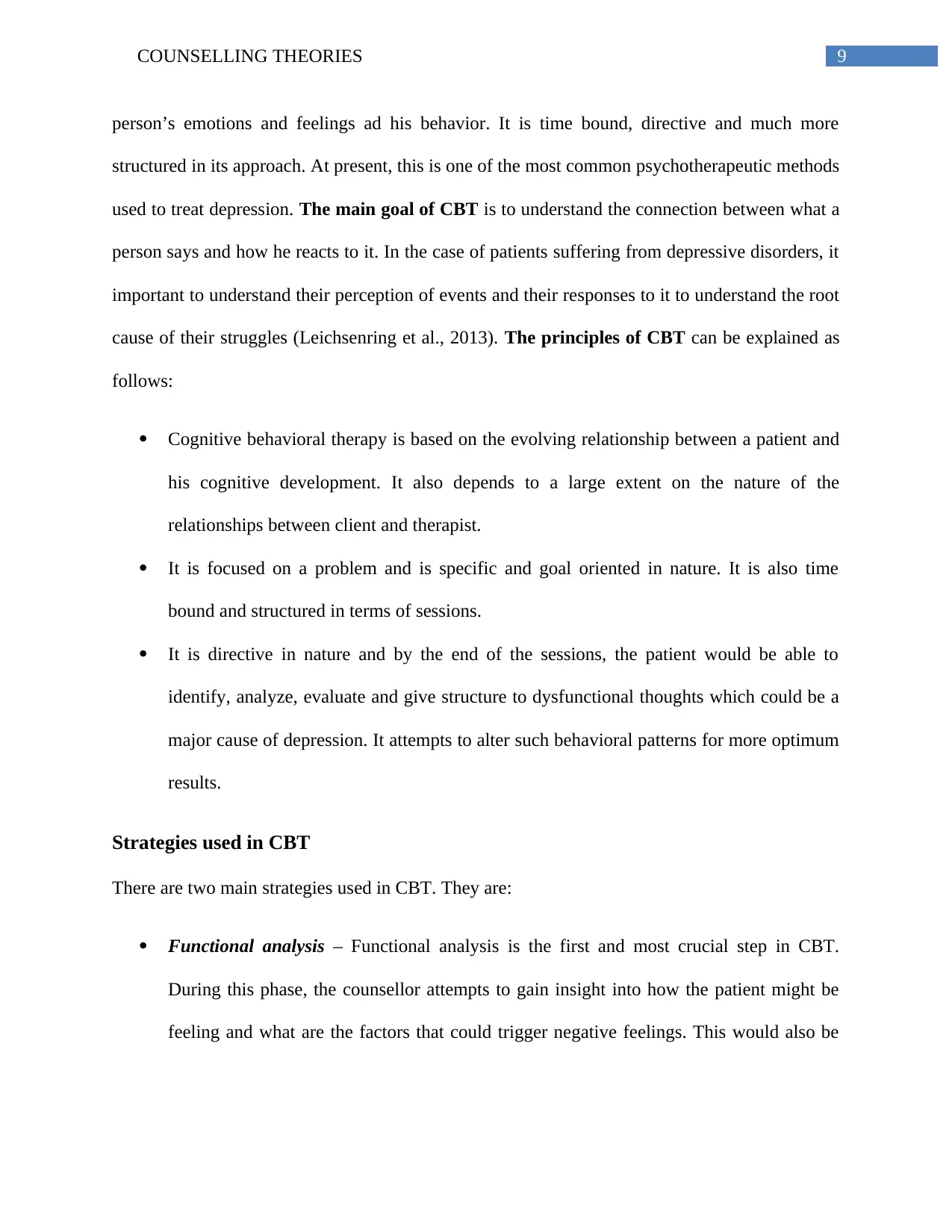
9COUNSELLING THEORIES
person’s emotions and feelings ad his behavior. It is time bound, directive and much more
structured in its approach. At present, this is one of the most common psychotherapeutic methods
used to treat depression. The main goal of CBT is to understand the connection between what a
person says and how he reacts to it. In the case of patients suffering from depressive disorders, it
important to understand their perception of events and their responses to it to understand the root
cause of their struggles (Leichsenring et al., 2013). The principles of CBT can be explained as
follows:
Cognitive behavioral therapy is based on the evolving relationship between a patient and
his cognitive development. It also depends to a large extent on the nature of the
relationships between client and therapist.
It is focused on a problem and is specific and goal oriented in nature. It is also time
bound and structured in terms of sessions.
It is directive in nature and by the end of the sessions, the patient would be able to
identify, analyze, evaluate and give structure to dysfunctional thoughts which could be a
major cause of depression. It attempts to alter such behavioral patterns for more optimum
results.
Strategies used in CBT
There are two main strategies used in CBT. They are:
Functional analysis – Functional analysis is the first and most crucial step in CBT.
During this phase, the counsellor attempts to gain insight into how the patient might be
feeling and what are the factors that could trigger negative feelings. This would also be
person’s emotions and feelings ad his behavior. It is time bound, directive and much more
structured in its approach. At present, this is one of the most common psychotherapeutic methods
used to treat depression. The main goal of CBT is to understand the connection between what a
person says and how he reacts to it. In the case of patients suffering from depressive disorders, it
important to understand their perception of events and their responses to it to understand the root
cause of their struggles (Leichsenring et al., 2013). The principles of CBT can be explained as
follows:
Cognitive behavioral therapy is based on the evolving relationship between a patient and
his cognitive development. It also depends to a large extent on the nature of the
relationships between client and therapist.
It is focused on a problem and is specific and goal oriented in nature. It is also time
bound and structured in terms of sessions.
It is directive in nature and by the end of the sessions, the patient would be able to
identify, analyze, evaluate and give structure to dysfunctional thoughts which could be a
major cause of depression. It attempts to alter such behavioral patterns for more optimum
results.
Strategies used in CBT
There are two main strategies used in CBT. They are:
Functional analysis – Functional analysis is the first and most crucial step in CBT.
During this phase, the counsellor attempts to gain insight into how the patient might be
feeling and what are the factors that could trigger negative feelings. This would also be
Secure Best Marks with AI Grader
Need help grading? Try our AI Grader for instant feedback on your assignments.
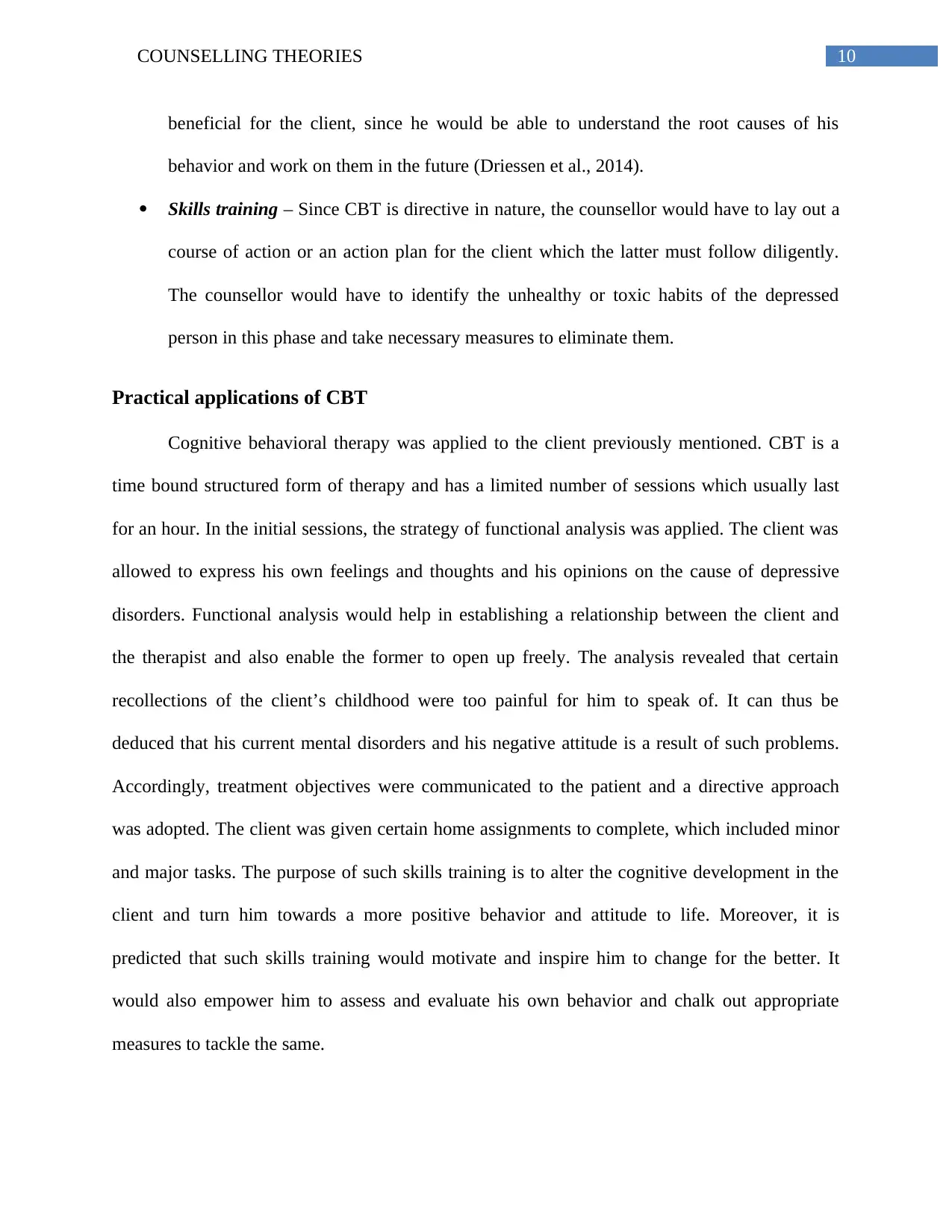
10COUNSELLING THEORIES
beneficial for the client, since he would be able to understand the root causes of his
behavior and work on them in the future (Driessen et al., 2014).
Skills training – Since CBT is directive in nature, the counsellor would have to lay out a
course of action or an action plan for the client which the latter must follow diligently.
The counsellor would have to identify the unhealthy or toxic habits of the depressed
person in this phase and take necessary measures to eliminate them.
Practical applications of CBT
Cognitive behavioral therapy was applied to the client previously mentioned. CBT is a
time bound structured form of therapy and has a limited number of sessions which usually last
for an hour. In the initial sessions, the strategy of functional analysis was applied. The client was
allowed to express his own feelings and thoughts and his opinions on the cause of depressive
disorders. Functional analysis would help in establishing a relationship between the client and
the therapist and also enable the former to open up freely. The analysis revealed that certain
recollections of the client’s childhood were too painful for him to speak of. It can thus be
deduced that his current mental disorders and his negative attitude is a result of such problems.
Accordingly, treatment objectives were communicated to the patient and a directive approach
was adopted. The client was given certain home assignments to complete, which included minor
and major tasks. The purpose of such skills training is to alter the cognitive development in the
client and turn him towards a more positive behavior and attitude to life. Moreover, it is
predicted that such skills training would motivate and inspire him to change for the better. It
would also empower him to assess and evaluate his own behavior and chalk out appropriate
measures to tackle the same.
beneficial for the client, since he would be able to understand the root causes of his
behavior and work on them in the future (Driessen et al., 2014).
Skills training – Since CBT is directive in nature, the counsellor would have to lay out a
course of action or an action plan for the client which the latter must follow diligently.
The counsellor would have to identify the unhealthy or toxic habits of the depressed
person in this phase and take necessary measures to eliminate them.
Practical applications of CBT
Cognitive behavioral therapy was applied to the client previously mentioned. CBT is a
time bound structured form of therapy and has a limited number of sessions which usually last
for an hour. In the initial sessions, the strategy of functional analysis was applied. The client was
allowed to express his own feelings and thoughts and his opinions on the cause of depressive
disorders. Functional analysis would help in establishing a relationship between the client and
the therapist and also enable the former to open up freely. The analysis revealed that certain
recollections of the client’s childhood were too painful for him to speak of. It can thus be
deduced that his current mental disorders and his negative attitude is a result of such problems.
Accordingly, treatment objectives were communicated to the patient and a directive approach
was adopted. The client was given certain home assignments to complete, which included minor
and major tasks. The purpose of such skills training is to alter the cognitive development in the
client and turn him towards a more positive behavior and attitude to life. Moreover, it is
predicted that such skills training would motivate and inspire him to change for the better. It
would also empower him to assess and evaluate his own behavior and chalk out appropriate
measures to tackle the same.
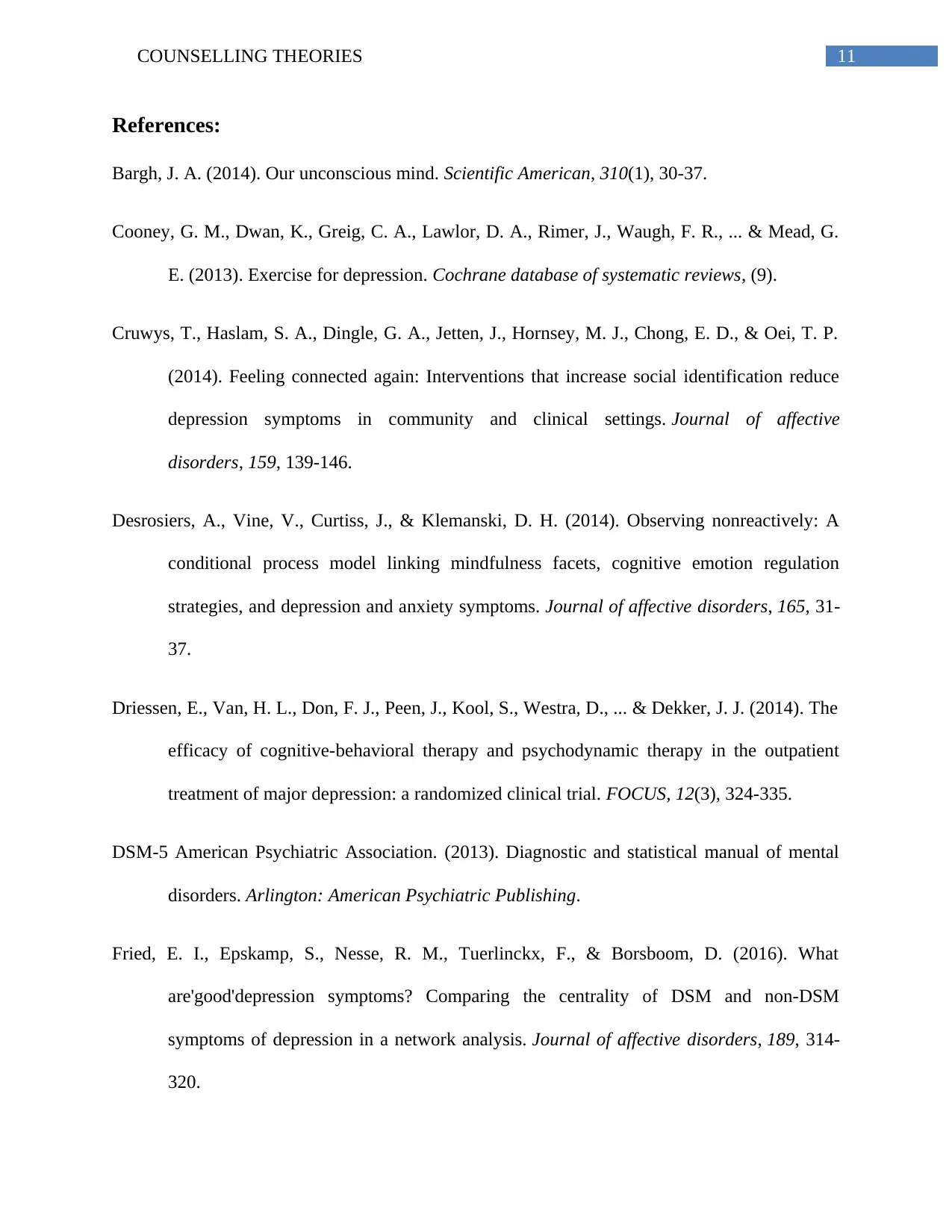
11COUNSELLING THEORIES
References:
Bargh, J. A. (2014). Our unconscious mind. Scientific American, 310(1), 30-37.
Cooney, G. M., Dwan, K., Greig, C. A., Lawlor, D. A., Rimer, J., Waugh, F. R., ... & Mead, G.
E. (2013). Exercise for depression. Cochrane database of systematic reviews, (9).
Cruwys, T., Haslam, S. A., Dingle, G. A., Jetten, J., Hornsey, M. J., Chong, E. D., & Oei, T. P.
(2014). Feeling connected again: Interventions that increase social identification reduce
depression symptoms in community and clinical settings. Journal of affective
disorders, 159, 139-146.
Desrosiers, A., Vine, V., Curtiss, J., & Klemanski, D. H. (2014). Observing nonreactively: A
conditional process model linking mindfulness facets, cognitive emotion regulation
strategies, and depression and anxiety symptoms. Journal of affective disorders, 165, 31-
37.
Driessen, E., Van, H. L., Don, F. J., Peen, J., Kool, S., Westra, D., ... & Dekker, J. J. (2014). The
efficacy of cognitive-behavioral therapy and psychodynamic therapy in the outpatient
treatment of major depression: a randomized clinical trial. FOCUS, 12(3), 324-335.
DSM-5 American Psychiatric Association. (2013). Diagnostic and statistical manual of mental
disorders. Arlington: American Psychiatric Publishing.
Fried, E. I., Epskamp, S., Nesse, R. M., Tuerlinckx, F., & Borsboom, D. (2016). What
are'good'depression symptoms? Comparing the centrality of DSM and non-DSM
symptoms of depression in a network analysis. Journal of affective disorders, 189, 314-
320.
References:
Bargh, J. A. (2014). Our unconscious mind. Scientific American, 310(1), 30-37.
Cooney, G. M., Dwan, K., Greig, C. A., Lawlor, D. A., Rimer, J., Waugh, F. R., ... & Mead, G.
E. (2013). Exercise for depression. Cochrane database of systematic reviews, (9).
Cruwys, T., Haslam, S. A., Dingle, G. A., Jetten, J., Hornsey, M. J., Chong, E. D., & Oei, T. P.
(2014). Feeling connected again: Interventions that increase social identification reduce
depression symptoms in community and clinical settings. Journal of affective
disorders, 159, 139-146.
Desrosiers, A., Vine, V., Curtiss, J., & Klemanski, D. H. (2014). Observing nonreactively: A
conditional process model linking mindfulness facets, cognitive emotion regulation
strategies, and depression and anxiety symptoms. Journal of affective disorders, 165, 31-
37.
Driessen, E., Van, H. L., Don, F. J., Peen, J., Kool, S., Westra, D., ... & Dekker, J. J. (2014). The
efficacy of cognitive-behavioral therapy and psychodynamic therapy in the outpatient
treatment of major depression: a randomized clinical trial. FOCUS, 12(3), 324-335.
DSM-5 American Psychiatric Association. (2013). Diagnostic and statistical manual of mental
disorders. Arlington: American Psychiatric Publishing.
Fried, E. I., Epskamp, S., Nesse, R. M., Tuerlinckx, F., & Borsboom, D. (2016). What
are'good'depression symptoms? Comparing the centrality of DSM and non-DSM
symptoms of depression in a network analysis. Journal of affective disorders, 189, 314-
320.
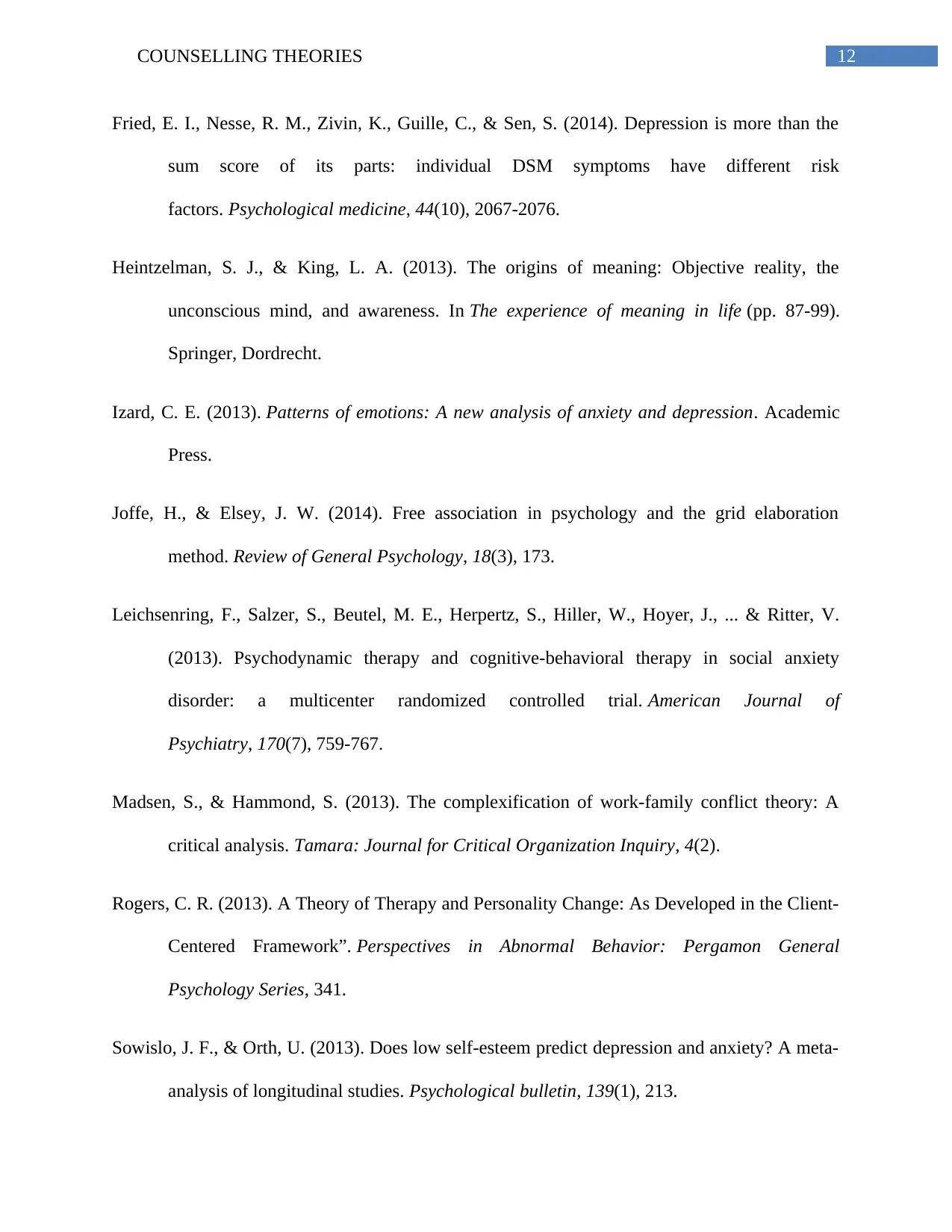
12COUNSELLING THEORIES
Fried, E. I., Nesse, R. M., Zivin, K., Guille, C., & Sen, S. (2014). Depression is more than the
sum score of its parts: individual DSM symptoms have different risk
factors. Psychological medicine, 44(10), 2067-2076.
Heintzelman, S. J., & King, L. A. (2013). The origins of meaning: Objective reality, the
unconscious mind, and awareness. In The experience of meaning in life (pp. 87-99).
Springer, Dordrecht.
Izard, C. E. (2013). Patterns of emotions: A new analysis of anxiety and depression. Academic
Press.
Joffe, H., & Elsey, J. W. (2014). Free association in psychology and the grid elaboration
method. Review of General Psychology, 18(3), 173.
Leichsenring, F., Salzer, S., Beutel, M. E., Herpertz, S., Hiller, W., Hoyer, J., ... & Ritter, V.
(2013). Psychodynamic therapy and cognitive-behavioral therapy in social anxiety
disorder: a multicenter randomized controlled trial. American Journal of
Psychiatry, 170(7), 759-767.
Madsen, S., & Hammond, S. (2013). The complexification of work-family conflict theory: A
critical analysis. Tamara: Journal for Critical Organization Inquiry, 4(2).
Rogers, C. R. (2013). A Theory of Therapy and Personality Change: As Developed in the Client-
Centered Framework”. Perspectives in Abnormal Behavior: Pergamon General
Psychology Series, 341.
Sowislo, J. F., & Orth, U. (2013). Does low self-esteem predict depression and anxiety? A meta-
analysis of longitudinal studies. Psychological bulletin, 139(1), 213.
Fried, E. I., Nesse, R. M., Zivin, K., Guille, C., & Sen, S. (2014). Depression is more than the
sum score of its parts: individual DSM symptoms have different risk
factors. Psychological medicine, 44(10), 2067-2076.
Heintzelman, S. J., & King, L. A. (2013). The origins of meaning: Objective reality, the
unconscious mind, and awareness. In The experience of meaning in life (pp. 87-99).
Springer, Dordrecht.
Izard, C. E. (2013). Patterns of emotions: A new analysis of anxiety and depression. Academic
Press.
Joffe, H., & Elsey, J. W. (2014). Free association in psychology and the grid elaboration
method. Review of General Psychology, 18(3), 173.
Leichsenring, F., Salzer, S., Beutel, M. E., Herpertz, S., Hiller, W., Hoyer, J., ... & Ritter, V.
(2013). Psychodynamic therapy and cognitive-behavioral therapy in social anxiety
disorder: a multicenter randomized controlled trial. American Journal of
Psychiatry, 170(7), 759-767.
Madsen, S., & Hammond, S. (2013). The complexification of work-family conflict theory: A
critical analysis. Tamara: Journal for Critical Organization Inquiry, 4(2).
Rogers, C. R. (2013). A Theory of Therapy and Personality Change: As Developed in the Client-
Centered Framework”. Perspectives in Abnormal Behavior: Pergamon General
Psychology Series, 341.
Sowislo, J. F., & Orth, U. (2013). Does low self-esteem predict depression and anxiety? A meta-
analysis of longitudinal studies. Psychological bulletin, 139(1), 213.
1 out of 13
Related Documents
Your All-in-One AI-Powered Toolkit for Academic Success.
+13062052269
info@desklib.com
Available 24*7 on WhatsApp / Email
![[object Object]](/_next/static/media/star-bottom.7253800d.svg)
Unlock your academic potential
© 2024 | Zucol Services PVT LTD | All rights reserved.





